戴尔PowerVault MD3400、3800系列解决方案
- 格式:pdf
- 大小:1.91 MB
- 文档页数:45
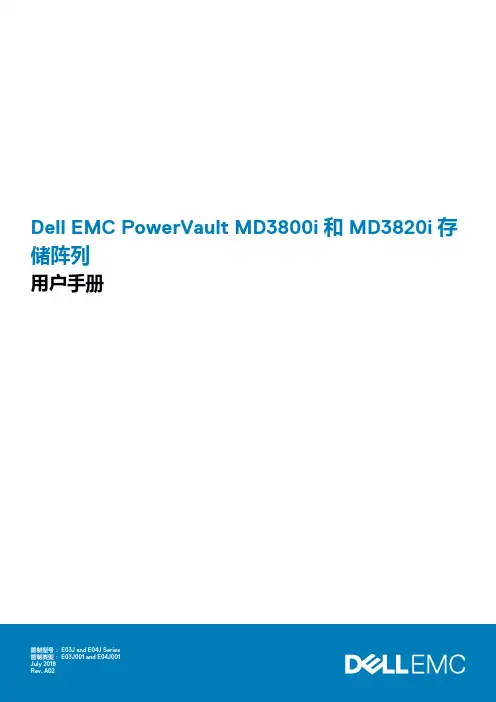
Dell EMC PowerVault MD3800i 和 MD3820i 存储阵列用户手册注意、小心和警告:“注意”表示帮助您更好地使用该产品的重要信息。
:“小心”表示可能会损坏硬件或导致数据丢失,并告诉您如何避免此类问题。
:“警告”表示可能会导致财产损失、人身伤害甚至死亡。
© 2015 - 2018 Dell Inc. 或其子公司。
保留所有权利。
Dell、EMC 和其他商标是 Dell Inc. 或其附属机构的商标。
其他商标可能是其各自所有者的商标。
章 1: 关于系统 (5)简介 (5)前面板功能部件和指示灯 (5)背面板功能部件和指示灯 (7)物理驱动器指示灯显示方式 (8)电源设备和冷却风扇功能部件 (8)电源指示灯代码和功能 (9)相关说明文件 (9)章 2: 控制器模块 (11)RAID 控制器模块 (11)RAID 控制器模块连接器及功能 (11)RAID 控制器模块 - 附加功能 (12)电池备用装置 (12)存储阵列热关机 (12)系统密码重设 (13)高速缓存的功能和特性 (13)高速缓存镜像 (13)回写式高速缓存 (13)直写式高速缓存 (13)章 3: 安装阵列组件 (14)建议工具 (14)前挡板(可选) (14)卸下前挡板 (14)安装前挡板 (15)物理驱动器 (15)安全型号 AMT E03J 和 E04J (15)卸下 2.5 英寸物理驱动器挡片 (15)安装 2.5 英寸物理驱动器挡片 (15)卸下 3.5 英寸物理驱动器挡片 (16)安装 3.5 英寸物理驱动器挡片 (16)卸下热交换物理驱动器 (16)安装热交换物理驱动器 (17)从物理驱动器托盘中卸下物理驱动器 (17)在物理驱动器托盘中安装物理驱动器 (19)RAID 控制器模块 (19)卸下 RAID 控制器模块挡片 (19)安装 RAID 控制器模块挡片 (19)卸下 RAID 控制器模块 (20)安装 RAID 控制器模块 (20)打开 RAID 控制器模块 (20)关闭 RAID 控制器模块 (21)RAID 控制器模块备用电池装置 (21)目录3卸下 RAID 控制器模块备用电池装置 (21)安装 RAID 控制器模块备用电池装置 (22)电源设备或冷却风扇模块 (22)卸下电源设备或冷却风扇模块 (22)安装电源设备或冷却风扇模块 (23)控制面板 (24)卸下控制面板 (24)安装控制面板 (25)背板 (25)卸下背板 (25)安装背板 (26)章 4: 系统故障排除 (27)存储阵列启动失败故障排除 (27)通信中断故障排除 (27)外部连接故障排除 (27)电源设备或冷却风扇模块故障排除 (28)阵列冷却问题故障排除 (28)扩展柜管理模块故障排除 (28)如果 EMM 状态 LED 呈琥珀色闪烁(每个序列为 5 次) (28)如果 EMM 状态 LED 呈琥珀色稳定亮起或闪烁(每个序列为 2 或 4 次) (28)如果链路状态 LED 并非绿色 (29)RAID 控制器模块故障排除 (29)如果阵列状态 LED 持续亮起或呈琥珀色闪烁 (29)如果链路状态 LED 并非绿色 (29)物理磁盘故障排除 (30)阵列和扩展柜连接故障排除 (30)受潮系统故障排除 (30)受损系统故障排除 (31)控制器故障情况 (31)严重情况 (31)非严重情况 (32)无效存储阵列 (32)ECC 错误 (32)PCI 错误 (32)章 5: 技术规格 (33)章 6: 获取帮助 (36)找到您的系统服务标签 (36)联系戴尔 (36)说明文件反馈 (36)4目录关于系统主题:•简介•前面板功能部件和指示灯•背面板 功能部件和指示灯•物理驱动器 指示灯显示方式•电源设备 和冷却风扇功能部件•电源指示灯 代码和功能•相关说明文件简介MD3800i 和 MD3820i 系列存储阵列在设计上追求高可用性,它可提供数据存储的冗余访问。
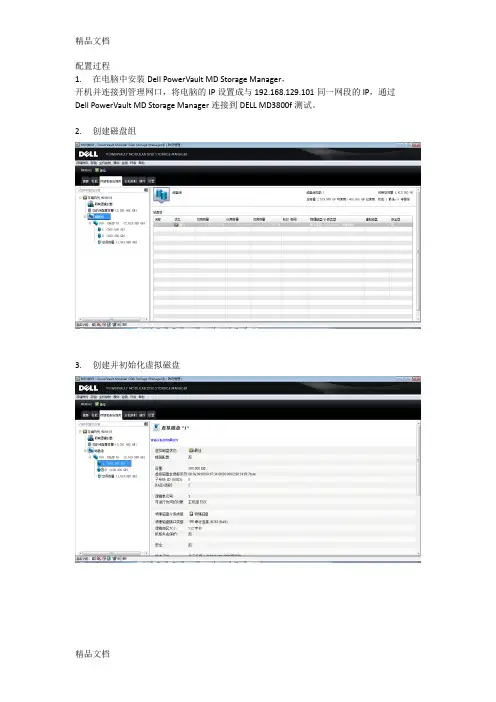

Matrices de almacenamiento Dell PowerVault MD3400/3420/3800i/3820i/3800f/3820f Guía de introducciónNotas, precauciones y advertenciasUna NOTA indica información importante que le ayuda a hacer un mejor uso de su producto.Una PRECAUCIÓN indica la posibilidad de daños en el hardware o la pérdida de datos, y le explica cómoUn mensaje de AVISO indica el riesgo de daños materiales, lesiones corporales o incluso la muerte.Copyright © 2014 Dell Inc. Todos los derechos reservados. Este producto está protegido por leyes internacionales y de los Estados Unidos sobre los derechos de autor y la propiedad intelectual. Dell™ y el logotipo de Dell son marcas comerciales de Dell Inc. en los Estados Unidos y en otras jurisdicciones. El resto de marcas y nombres que se mencionan en este documento, puede ser marcas comerciales de las compañías respectivas.Instalación y configuraciónAntes de realizar el procedimiento siguiente, revise las instrucciones de seguridad incluidas con el sistema.Temas:•Desembalaje de un sistema rack •Conexión de los cables de alimentación •Fijación de los cables de alimentación •Cómo encender el sistema •Instalación del bisel •Acuerdo de licencia de Dell Software •Otra información útil •Obtención de asistencia técnica •Información de la NOM•Especificaciones técnicasDesembalaje de un sistema rackIlustración 1. Instalación del sistema en un rack Desembale el sistema e identifique cada elemento.Ensamble los rieles e instale el sistema en el rack siguiendo las instrucciones de seguridad y de instalación del rack incluidas con el sistema.1Instalación y configuración 3Conexión de los cables de alimentaciónIlustración 2. Conexión de los cables de alimentaciónConecte los cables de alimentación del sistema al sistema.Fijación de los cables de alimentaciónIlustración 3. Fijación de los cables de alimentaciónAbra el soporte de rentención del cable tirando de las pestañas en los lados, introduzca el cable y asegure el cable de alimentación del sistema, como se muestra en la ilustración.Conecte el otro extremo de los cables de alimentación a una toma de corriente con conexión a tierra o a otra fuente de alimentación, como una fuente de alimentación ininterrumpida (UPS) o una unidad de distribución de alimentación (PDU).4Instalación y configuraciónCómo encender el sistemaIlustración 4. Cómo encender el sistemaGire el conmutador de alimentación hacia la parte posterior del sistema en la posición de encendido. Se debe encender el LED de alimentación.Instalación del biselIlustración 5. Instalación del biselInstale el bisel tal como se muestra en la ilustración.Acuerdo de licencia de Dell SoftwareAntes de utilizar el sistema, lea el Acuerdo de licencia de Dell Software que se incluye. Debe considerar cualquier soporte de software instalado por Dell como una copia de RESPALDO del software instalado en el disco duro de su sistema. Si no acepta las condiciones del contrato, llame al número de teléfono de asistencia al cliente. Los clientes de los Estados Unidos pueden llamar al 800-WWW-DELL (800-999-3355). Los clientes ubicados fuera de los Estados Unidos pueden visitar /support y seleccionar su país o región en la parte superior izquierda de la página.Otra información útilConsulte la información reglamentaria y de seguridad proporcionada con el sistema. La información sobre la •En el Manual del propietario, se proporciona información acerca de las funciones del hardware del sistema y se describe cómo solucionar problemas del sistema e instalar o sustituir componentes del sistema. Este documento está disponible en línea en / support/manuals.Instalación y configuración5•En la Guía del administrador , se proporciona información sobre las funciones del software Administrador de almacenamiento en disco modular y describe cómo configurar y administrar su sistema de disco modular. Este documento está disponible en línea en /support/manuals .•En la Guía de implementación , se proporciona información sobre el cableado del sistema y sobre la instalación y configuración inicial del software Administrador de almacenamiento en disco modular . Este documento está disponible en línea en /support/manuals .•Para obtener vídeos y otros recursos sobre PowerVault MD series, consulte /PVresources .•En la documentación del rack incluida con la solución de rack se describe cómo instalar el sistema en un rack, si es necesario.•En el soporte suministrado con el sistema se incluye documentación y herramientas para configurar y administrar el sistema, incluidaslas relacionadas con el sistema operativo, el software de administración de sistema, las actualizaciones del sistema y los componentes del sistema adquiridos con él.Compruebe si hay actualizaciones en /support/manuals y, si las hay, léalas antes de proceder a laSe recomienda la descarga e instalación del firmware de administración de sistemas en el sistema desdeObtención de asistencia técnicaSi no comprende alguno de los procedimientos descritos en esta guía o si el sistema no funciona del modo esperado, consulte el Owner’s Manual (Manual del propietario ). Dell cuenta con una amplia oferta de capacitación y certificación de hardware. Consulte /training para obtener más información. Es posible que este servicio no se ofrezca en todas las regiones.Información de la NOMLa información que se proporciona a continuación aparece en el dispositivo descrito en este documento, de conformidad con los requisitos de la Norma Oficial Mexicana (NOM):Importador:Dell Inc. de México, S.A. de C.V.Paseo de la Reforma 2620 -11º PisoCol. Lomas Altas11950 México, D.F.Número de modelo:E03J y E04JVoltaje de alimentación:100 – 240 V CAFrecuencia:50/60 HzConsumo eléctrico:8,6 AEspecificaciones técnicas Las especificaciones siguientes son únicamente las que deben incluirse por ley con el envío del equipo. Para AlimentaciónFuente de alimentación de CA (por fuente de alimentación)Potencia600 WLa disipación de calor se calcula utilizando100 W Voltaje 100–240 VCA (8,6 A–4,3 A)6Instalación y configuraciónAlimentaciónEste sistema ha sido diseñado tambiénBatería6,6 V CC, 1100 mAh, Batería de iones de litio de 7,26 WCaracterísticas físicasPowerVault MD3400/MD3800f/MD3800iAltura8,68 cm (3,41 pulgadas)Anchura44,63 cm (17,57 pulgadas)Profundidad60,20 cm (23,70 pulgadas)Peso (configuración máxima)29,30 kg (64,6 libras)Peso (vacío)8,84 kg (19,5 libras)PowerVault MD3420/MD3820f/MD3820iAltura8,68 cm (3,41 pulgadas)Anchura44,63 cm (17,57 pulgadas)Profundidad54,90 cm (21,61 pulgadas)Peso (configuración máxima)24,22 kg (53,4 libras)Peso (vacío)8,61 kg (19 libras)EntornoTemperatura20 °C por hora (36 °F por hora)Gradiente de temperatura máximo (en funcionamiento yalmacenamiento)Límites de temperatura de almacenamiento De –40 °C a 65 °C (de –40 °F a 149 °F)Temperatura (Operación continua)De 10 °C a 35 °C (50 °F a 95 °F) sin que le de el sol al equipo Intervalos de temperatura (para altitudes inferiores a950 m o 3117 pies)Para obtener información sobre las configuraciones yManual del propietario en /Intervalo del porcentaje de humedad De 10% a 80% de humedad relativa con un punto de condensaciónmáximo de 26 °C (78,8 °F).Humedad relativaAlmacenamiento De 5% a 95% de HR con un punto de condensación máximo de 33 °C(91 °F). La atmósfera debe estar sin condensación en todo momento Vibración máximaEn funcionamiento0,26 G rms de 5 Hz a 350 Hz en orientación de funcionamientoAlmacenamiento1,88 G rms de 10 Hz a 500 Hz durante 15 minutos (evaluados los seislaterales)Impacto máximoInstalación y configuración7EntornoEn funcionamiento Un impulso de descarga en el sentido positivo del eje z (un impulso encada lado del sistema) de 31 G durante 2,6 m en la orientación defuncionamiento.AlmacenamientoSeis impulsos de descarga ejecutados consecutivamente en los ejes x, y yz positivos y negativos (un impulso en cada lado del sistema) de 71 Gdurante un máximo de 2 m.AltitudEn funcionamiento De –30,5 m a 30482000 m (de –50 pies a 10 0006560 pies).Para altitudes superiores a 2.950 pies, la temperaturaAlmacenamientoHasta 12 000 m ( 39 370 pies).Reducción de valores nominales de altitud enfuncionamiento Una temperatura máxima de hasta 35 °C (95 °F) se reduce 1 °C cada 300 m (1 °F cada 547 pies) por encima de los 950 m (3117 pies)Una temperatura máxima de 35 °C a 40 °C (95 °F a 104 °F) se reduce 1°C cada 175 m (1 °F cada 319 pies) por encima de los 950 m (3117 pies)Una temperatura máxima de 40 °C a 45 °C (104 °F a 113 °F) se reduce1°C cada 125 m (1 °F cada 228 pies) por encima de los 950 m (3117 pies)Esta sección define los límites para evitar daños en el equipo de TI y/o errores de la contaminación gaseosa y deSe aplica solo a los entornos de centroISO clase 8 por ISO 14644-1 define la filtración de aire de centro de datos El aire que entre en el centro de datos tiene que tenerSe aplica a entornos de centro de datosEl aire debe estar libre de polvo conductor, filamentos de zinc u otras partículas conductoras.Se aplica a entornos de centro de datos •El aire debe estar libre de polvo corrosivo.•El polvo residual que haya en el aire debe tener un punto delicuescente inferior a una humedad relativa del 60%.Contaminación gaseosa Níveles máximos de contaminación corrosiva medidos al ≤50% de humedad relativaVelocidad de corrosión del cupón de cobre<300 Å cada mes por Clase G1 de acuerdo con ANSI/ISA71.04-1985.Velocidad de corrosión del cupón de plata <200 Å cada mes de acuerdo con AHSRAE TC9.9.8Instalación y configuración。
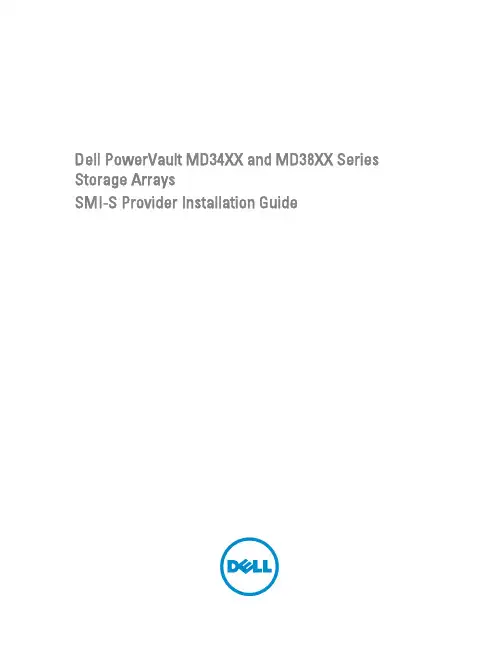
Dell PowerVault MD34XX and MD38XX Series Storage ArraysSMI-S Provider Installation GuideNotes, Cautions, and WarningsNOTE: A NOTE indicates important information that helps you make better use of your computer.CAUTION: A CAUTION indicates either potential damage to hardware or loss of data and tells you how to avoid the problem.WARNING: A WARNING indicates a potential for property damage, personal injury, or death.Copyright © 2014 Dell Inc. All rights reserved. This product is protected by U.S. and international copyright and intellectual property laws. Dell™ and the Dell logo are trademarks of Dell Inc. in the United States and/or other jurisdictions. All other marks and names mentioned herein may be trademarks of their respective companies.2014 - 02Rev. A03Contents1 SMI-S Provider Installation Guide (5)Introduction (5)Version Information (5)Name Space (5)Supported Profiles And Sub-Profiles (5)Installing And Uninstalling The SMI-S Provider (6)System Requirements For SMI-S Provider (6)Installing SMI-S Provider (7)Configuring CIM Server (7)Uninstalling SMI-S Provider (9)Managing The SMI-S Provider (9)Starting And Stopping The OpenPegasus CIM Server For Windows-Based Operating Systems (9)Starting And Stopping The OpenPegasus CIM Server For Linux-Based Operating Systems (9)Adding Or Removing A Storage Array From The SMI-S Provider (9)Changing The Debug Tracing Option (9)Troubleshooting The SMI-S Provider (10)4SMI-S Provider Installation GuideIntroductionThe Dell PowerVault MD Series storage arrays provide an industry-standard Application Programming Interface (API) called the Storage Management Initiative Specification (SMI-S). This interface enables third party SMI-S client applications to manage MD Series storage arrays in a multi-vendor storage area network (SAN) environment.SMI-enabled management applications are known as Common Information Model (CIM) clients. To allow clients to manage a storage device, an SMI-S Provider (also called SMI-S Agent or CIM Agent) is required. SMI-S Providers can be implemented as:• A proxy interface that translates the existing API of a device to an SMI-S compliant interface. This implementation is the quickest path to SMI-S compliance, but a proxy provider and a Common Information Model Object Manager (CIMOM) must be installed on a server. A CIMOM is a CIM/WBEM infrastructure that receives, validates, and authenticates CIM requests from the client application. The CIMOM directs the requests to the appropriate device provider.• A native feature of the storage device API. This implementation is sometimes referred to as an embedded agent. Dell MD Series SMI-S Provider is implemented as a proxy interface. The Dell SMI-S Provider, referred to as SMI-S Provider, runs on a server on the storage network. OpenPegasus CIMOM is installed during the installation of this SMI-S Provider.The SMI-S Provider provides the SMI-S interface to the Dell PowerVault MD Series storage arrays. The provider uses the proxy CIM Agent model and is supported on Microsoft Windows and Linux platforms only. For more information about the platform versions, see the Support Matrix for the MD Series storage arrays at /powervaultmanuals. Version InformationThe following table lists the version details of the components.Component VersionSMI-S 1.4SMI-S Provider10.302.9.1OpenPegasusCIMOMName SpaceEXTERNAL_NAMESPACE=root/DCIM/MDStorageArray13Supported Profiles And Sub-ProfilesSMI-S Provider version 10.30 supports the following profiles and sub-profiles:•Block storage views•Thin provisioning•Replication services•Physical package•Profile registration5•Device credentials•Proxy server system management•Multiple computer system•Block services•Disk drive lite•Copy services•Job control•Extent composition•Disk sparing•Initiator port (SAS and SATA)•Target port (SAS)•iSCSI target port•Access points•Indications•Masking and mapping•Location•Software inventory•Software update•Erasure•Battery•Storage asymmetry•Message log•Block server performanceNOTE: Block server performance statistics are not available for controller firmware versions prior to 7.10. Installing And Uninstalling The SMI-S ProviderSystem Requirements For SMI-S ProviderThe following are the system requirements to install and run the SMI-S Provider.System Component RequirementMemory 1 GB minimum (2 GB recommended).Connectivity Ethernet with 100BASE-T minimum (Gigabit Ethernet preferred) and TCP/IP.Port TCP port 5988 or 5989, or any other available port if these ports are not available.Storage array password The device credentials profile requires the storage array password (SharedSecret) to modify operations. The SMI-S Provider persistently tracks an instance of the SharedSecret per storage array.Scalability There is no limit on the number of storage systems that can be supported by a single provider instance. The recommended maximum is 10 for moderately to fully configured storage systemsper provider, or a total of around 5000 volumes. In large configurations, deploy additionalproviders on different servers in your storage network to manage additional storage systems. 6Installing SMI-S ProviderThe SMI-S Provider is packaged as an archive file for UNIX-based operating system servers and as an executable installation file for Microsoft Windows-based operating system servers.Installing SMI-S Provider For Windows-Based Operating SystemsTo install the SMI-S Provider:1.Move the SMI-S Provider installation executable file on the server where you want to install the SMI-S Provider.2.Double-click the installation executable icon and follow the instructions on the screen.NOTE: The installation prompts you to enter an IP address for the storage array that you want to use. The installation opens a text file in Notepad. Follow the instructions in the text file. After you have added the storage array and closed Notepad, the installation program continues normally.The SMI-S Provider is installed on your system. After the installation, you can delete the installation executable file.Installing SMI-S Provider For Linux-Based Operating SystemsTo install the SMI-S Provider:1.Move the SMI-S Provider RPM package file into the file system on the server where you want to install SMI-S Provider.2.Run the following command: rpm -ivh <rpm package name> .rpmTo change the OpenPegasus CIMOM configuration, see Configuring CIM Server.Configuring CIM ServerUse the following commands to perform basic CIM server configuration operations.Function CommandTo set an http port # cimconfig -s httpPort=<port> -p To set an https port # cimconfig -s httpsPort==<port> -pTo enable or disable the http connection # cimconfig -s enableHttpConnection={true | false} -p To enable or disable the https connection # cimconfig -s enableHttpsConnection={true | false} -p To enable or disable authentication# cimconfig -s enableAuthentication={false | true} –pTo add a user fordefining thecredentials for CIM client to authenticate with the CIM server cimuser -a -u username -w password To remove a user# cimuser -r -u username -w password7Function Command To enable or disableservice location protocol (SLP)# cimconfig -s slp={true | false} -pNOTE:If SLP is enabled, see the table below for additional settings information.NOTE: Commands are of the following format: cimconfig -s<propertyName>={true|false} -p where <propertyName> is a column heading in the following table.Table 1. Additional Setting Information if SLP is EnabledNOTE: All other combinations of the SLP property values have undefined behavior.For more information, see the documentation available in the source release archive at . 8Uninstalling SMI-S ProviderUninstalling SMI-S Provider For Windows-Based Operating Systems1.Navigate to the Control Panel.2.Click Add or Remove Programs.3.Double-click Dell SMI-S Provider to uninstall it.The uninstallation procedure may leave files (such as trace files, repository files, and other administrative files) that were created by SMI-S Provider after the installation was complete. Manually delete these files to completely remove SMI-S Provider.Uninstalling SMI-S Provider For Linux-Based Operating Systems1.In a terminal window, run the command: rpm -e <package name>The un-installation process may leave files that were not part of the original installation.2.Manually delete the original installation files to completely remove SMI-S Provider.Managing The SMI-S ProviderStarting And Stopping The OpenPegasus CIM Server For Windows-Based Operating SystemsTo start or stop the OpenPegasus CIM server:1.Open the Services window and locate the cimserver service.2.Right-click cimserver service and select start or stop.3.To start a service, run the following command in the command prompt: net start cimserver4.To stop a service, run the following command in the command prompt: net stop cimserverStarting And Stopping The OpenPegasus CIM Server For Linux-Based Operating Systems1.To start the OpenPegasus CIM server, run the following command on a terminal window: cimserver2.To stop the OpenPegasus CIM server, run the following command on a terminal window: cimserverAdding Or Removing A Storage Array From The SMI-S ProviderDuring installation, you are prompted to enter the IP addresses into a file. After this initial setup, the SMI-enabled client must use the SMI-S Provider proxy server system management profile to add or remove devices.NOTE: When a storage array is added, the IP address of only one of the management ports of the storage array must be supplied (and not both management ports). Entering the IP addresses for both management ports of a single storage array causes unpredictable behavior of the SMI-S Provider.Changing The Debug Tracing OptionNOTE: After changing the tracing levels, stop and start OpenPegasus CIM server for the changes to take effect.Turn on tracing only under the direction of your technical support representative.9To change the debug tracing option:1.Go to the directory where SMI-S Provider is installed.The default install directories are:–<%Program Files%>/Dell/pegasus/provider/array for Windows.–/opt/dell/pegasus/array for Linux.2.Edit providerTraceLog.properties file in a text file editor, by following the steps below:a)Remove the pound sign (#) from the lines containing File, Level, and Events.b)Edit the file name in the field File.This file contains the trace messages.3.Save providerTraceLog.properties file and exit the text file editor.4.Stop and start the OpenPegasus CIM server.See Starting And Stopping The OpenPegasus CIM Server. Troubleshooting The SMI-S ProviderThe following table lists some of the common issues and their resolutions.Table 2. Common Issues and Resolutions1011。

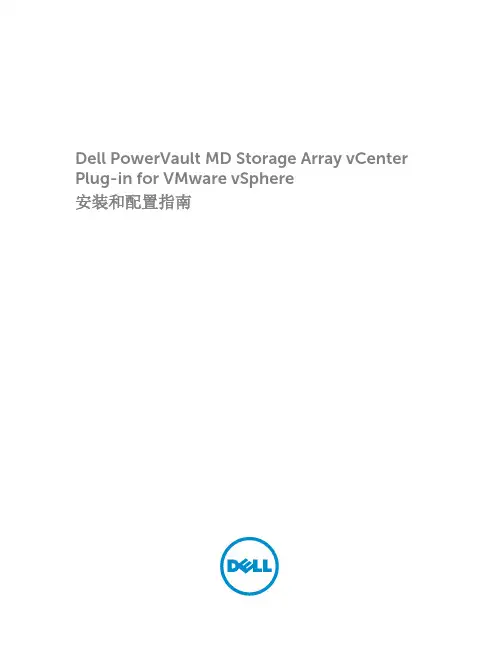
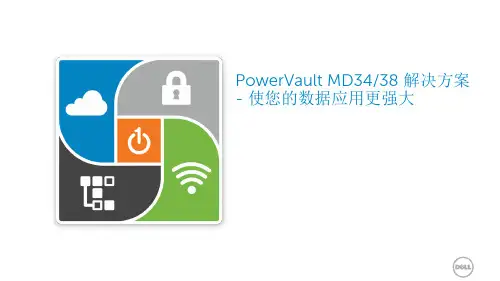
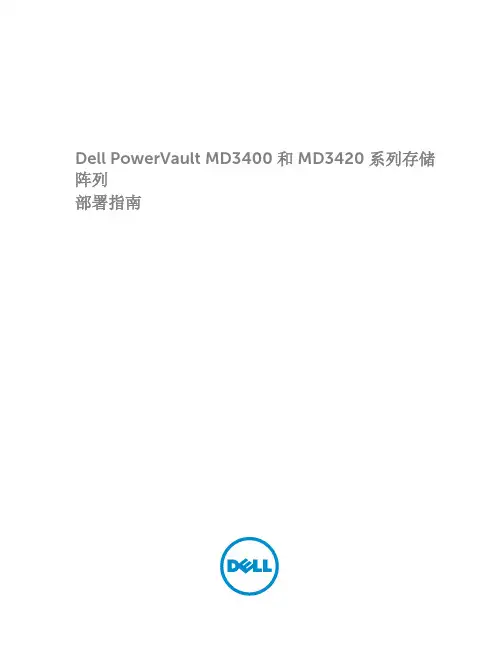
Dell PowerVault MD3400 和 MD3420 系列存储阵列部署指南注、小心和警告注: “注”表示可以帮助您更好地使用计算机的重要信息。
小心: “小心”表示可能会损坏硬件或导致数据丢失,并说明如何避免此类问题。
警告: “警告”表示可能会造成财产损失、人身伤害甚至死亡。
版权所有© 2014 Dell Inc. 保留所有权利。
本产品受美国、国际版权和知识产权法律保护。
Dell™和 Dell 徽标是 Dell Inc. 在美国和 / 或其他管辖区域的商标。
所有此处提及的其他商标和产品名称可能是其各自所属公司的商标。
2014 - 02Rev. A00目录1 简介 (5)系统要求 (5)管理站要求 (5)存储阵列简介 (5)相关说明文件 (6)找到您的系统服务标签 (6)联系 Dell (7)说明文件反馈 (7)2 硬件安装 (8)规划存储配置 (8)连接存储阵列 (8)存储阵列布线 (9)冗余和非冗余配置 (9)单控制器配置 (9)双控制器配置 (13)PowerVault MD1200 系列扩展柜布线 (19)使用之前已配置的 PowerVault MD1200 系列扩展柜进行扩展 (20)使用新的 PowerVault MD1200 系列扩展柜进行扩展 (20)3 安装 PowerVault MD 存储软件 (22)图形化安装(推荐) (22)控制台安装 (23)无提示安装 (24)在 Windows 系统中进行无提示安装 (24)在 Linux 系统中进行无提示安装 (24)升级 MD 存储软件 (24)4 卸载 MD 存储软件 (25)从 Windows 中卸载 MD 存储软件 (25)从 Windows Server GUI 版本卸载 MD 存储软件 (25)从 Windows Server Core 版本卸载 MD 存储软件 (25)从 Linux 中卸载 MD 存储软件 (25)5 负载平衡 (26)负载平衡策略 (26)带子集的轮询 (26)最少队列深度 (26)最少路径权重 (26)更改 Windows Server 操作系统的负载均衡策略 (26)1简介本说明文件提供了关于部署 Dell PowerVault MD3400 和 Dell PowerVault MD3420 存储阵列的信息。
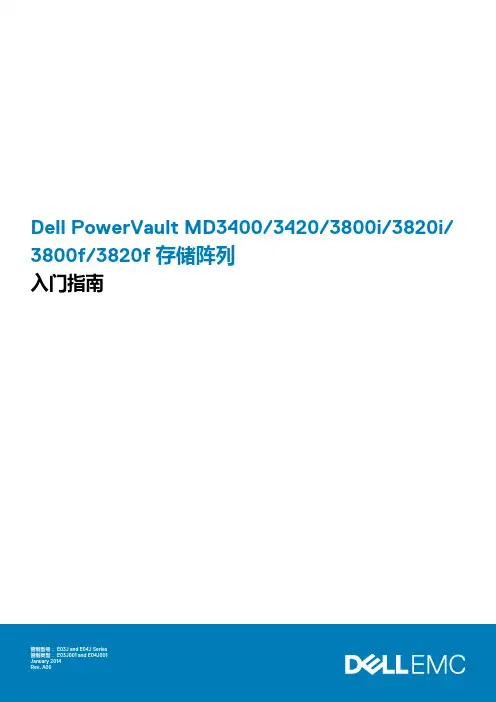
Dell PowerVault MD3400/3420/3800i/3820i/ 3800f/3820f 存储阵列入门指南注意、小心和警告:“注意”表示帮助您更好地使用该产品的重要信息。
:“小心”表示可能会损坏硬件或导致数据丢失,并告诉您如何避免此类问题。
:“警告”表示可能会导致财产损失、人身伤害甚至死亡。
版权所有 © 2014 Dell Inc. 保留所有权利。
本产品受美国、国际版权和知识产权法律保护。
Dell™和 Dell 徽标是 Dell Inc. 在美国和 / 或其他管辖区域的商标。
所有此处提及的其他商标和产品名称可能是其各自所属公司的商标。
安装和配置: 执行下列步骤之前,请阅读系统随附的安全说明。
主题:•打开机架系统包装•连接电源电缆•固定电源电缆•开启系统•安装挡板•Dell 软件许可协议•您可能需要的其他信息•获得技术协助•NOM 信息•技术规格打开机架系统包装图 1: 在机架中安装系统打开系统包装并识别每项物品。
遵循系统随附的安全说明和机架安装说明组装滑轨,并在机架中安装系统。
1安装和配置3连接电源电缆图 2: 连接电源电缆将系统的电源电缆连接到系统上。
固定电源电缆图 3: 固定电源电缆拉其两侧的弹片以打开电缆固定支架,插入电缆并固定系统电源电缆,如图中所示。
将电源电缆的另一端插入接地的电源插座或单独的电源,如不间断电源设备 (UPS) 或配电装置 (PDU)。
开启系统图 4: 开启系统4安装和配置将系统背面的电源开关转至 On(打开)位置。
电源 LED 指示灯会亮起。
安装挡板图 5: 安装挡板按照图示安装挡板。
Dell 软件许可协议在使用您的系统之前,请先阅读您的系统随附的《Dell 软件许可协议》。
您必须将 Dell 已安装软件的介质认为是已安装在您系统硬盘驱动器上的软件的备份副本。
如果您不接受该协议的条款,请拨打客户帮助电话号码。
美国境内客户请拨打 800-WWW-DELL (800-999-3355)。

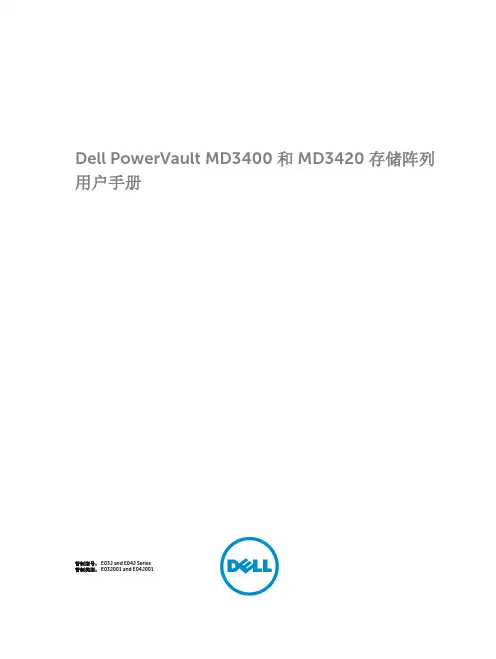
Dell™ PowerVault™数据保护解决方案系统恢复指南w w w.d e l l.c o m|s u p p o r t.d e l l.c o m注、注意和警告注:“注”表示可以帮助您更好地使用计算机的重要信息。
注意:“注意”表示可能会损坏硬件或导致数据丢失,并告诉您如何避免此类问题。
警告:“警告”表示可能会导致财产损失、人身伤害甚至死亡。
____________________本说明文件中的信息如有更改,恕不另行通知。
©2007Dell Inc. 版权所有,翻印必究。
未经 Dell Inc. 书面许可,严禁以任何形式进行复制。
本文中使用的商标:Dell、DELL徽标、PowerEdge、PowerVault和 Dell OpenManage 是Dell Inc. 的商标;Microsoft、Windows、SQL Server和Windows Server是 Microsoft Corporation 在美国和/或其它国家/地区的商标或注册商标。
本说明文件中述及的其它商标和产品名称是指拥有相应商标和产品名称的公司或其制造的产品。
Dell Inc. 对本公司的商标和产品名称之外的其它商标和产品名称不拥有任何专有权。
2007 年 11 月修订版 A00目录1简介 (5)2恢复解决方案图 (7)3从磁盘故障中恢复 (9)检测并监测磁盘故障 (9)RAID 适配器声音警报 (9)OpenManage™ Server Administrator (9)Dell OpenManage™ IT Assistant (10)更换磁盘 (10)更换内部磁盘 (10)更换外部存储设备硬盘柜中的磁盘 (11)从磁盘故障中恢复 (11)单个磁盘故障恢复 (11)多个磁盘故障恢复 (12)4重新安装操作系统 (13)使用 Dell Systems Build and Update Utility (13)BIOS、固件和驱动程序更新 (22)使用 Windows Update 执行 OS 更新 (22)目录3本地化操作系统 (22)安装多语种用户界面软件包 (22)应用 MUI 语言: (23)5重新安装 OMSA (25)6重新安装 DPM (27)预先必备的软件和网络配置 (27)DPM 存储池的虚拟磁盘配置 (29)DPM 安装 (29)DPM 更新 (32)7重新安装 PowerVault 数据保护解决方案配置向导 (33)安装向导 (33)运行向导 (33)8恢复 DPM 数据库和副本 (35)9其它说明文件和资源 (37)Microsoft 信息 (37)Dell 硬件信息 (37)Dell 软件信息 (38)4目录简介5简介本说明文件介绍了从多种硬件或软件故障中恢复 Dell™ PowerVault™ 数据保护解决方案的必需步骤。
Dell PowerVault MD 存储阵列多功能、模块化、智能化数据管理戴尔的 独特之处:简化是我们的一贯理念我们致力于帮助您通过简化IT 来节省时间和资源。
恪守标准是我们的坚定承诺我们不依赖专有技术,而是构建基于标准的系统。
智能自动化我们的系统简单易用,可以让您的IT 团队解放出来,集中精力实施更重要的计划。
根据增长渐进扩展的模块化我们的存储解决方案是完全模块化的。
您只需购买您所需要的容量,然后随着数据存储需求的增长来增加容量。
简化ITDell PowerVault MD 3200/3600/1200系列存储阵列可以优化数据存储体系结构、确保数据可用性,进而简化IT 。
这样,就可以将宝贵的资源释放出来,有助于降低成本,并使创新成为日常行为。
为了满足您的特定业务需求,MD 3200/3600/1200系列存储阵列支持iSCSI 、光纤通道或SAS 技术。
Dell PowerVault MD 存储阵列经验证的MD 系列阵列,可提供持续的灵活性、可扩展性和价值PowerVault MD3600f 和MD3620f 阵列将光纤通道引入了MD 系列。
凭借每控制器四个8 Gb/s 端口,可提高数据密集型应用程序的吞吐量;同时,通过远程复制功能,可扩展业务连续性。
MD3600f 和MD3620f 秉承了经验证的MD 系列阵列一贯的向后兼容性。
通过MD1200或MD1220扩展盘柜,可以对MD3600系列阵列进行扩展,最多可支持64台主机和96个驱动器。
此外,多协议、多代式MD Storage Manager 软件提供简单直观的阵列管理界面,可实现卓越的灾难恢复与业务连续性平台。
超凡的整合与虚拟化基于iSCSI 的PowerVault MD3200i/MD3220i 和MD3600i/ MD3620i 系列存储区域网络(SAN)阵列可提供强大的系统功能、性能和灵活性,适用于存储整合与虚拟化部署。
MD3600i 系列采用紧凑的2U 外形规格,支持高带宽、 10 GbE 直接连接或SAN 连接以及多达64台主机;MD3200i 系列支持1 GbE 直接连接或SAN 连接以及多达32台物理服务器。
目录1MD3400存储系统安装 (2)1.1物理连接 (2)1.2管理机安装MD管理软件 (2)1.3配置MD3400 (4)2MD3400多路径软件 (12)2.1扫描虚拟磁盘 (12)2.2使用多路径命令显示多路径拓扑 (12)2.3设置多路径设备别名 (12)2.4重启multipathd服务 (14)1MD3400存储系统安装1.1物理连接MD3400存储与两台产品数据库服务器双机之间的物理连接如下图(因为产品数据库服务器每台实际配置一块SAS-HBA卡,所以图中第二块卡连接忽略):1.2管理机安装MD管理软件在一台Win7以上或Linux系统的管理机上,安装随机光盘中的MD存储管理软件(如果光盘丢失可以从Dell官网下载):SMIA-WinX64(windows)/SMIA-LINUXX64(linux)。
MD3400存储两个控制器的管理口默认IP地址为:192.168.129.101/24、192.168.129.102/24。
配置管理机IP地址为同一网段,并通过交换机同时连接两个控制器的管理口。
运行管理软件,在初始Setup页面选择自动发现:发现MD3400存储即可进行后续配置了:1.3配置MD3400 定义存储阵列名称:点OK继续:选择创建存储:选择创建磁盘组:输入磁盘组名称,点下一步:创建8个虚拟磁盘,5个1G的ASM盘、一个200G的ARCHIVELOG、一个100GFLASH、剩余空间全部给DATE:定义主机:输入主机名称:输入主机SAS-HBA卡的端口号(添加两个):创建主机组:输入主机组名称:在Host Mappings页面把虚拟磁盘映射给主机组:在首选项页面调整操作系统参数:2MD3400多路径软件在两台产品数据库服务器上运行 MD Series 存储阵列资源 DVD 安装程序,然后选择“完整安装”或“主机安装”选项,将所需的 Device Mapper 软件组件安装在 Linux 主机服务器上。
Dell™ PowerVault™ MD Storage Arrays ManagementPack Suite Version 4.0 For Microsoft® System Center Operations Manager 2007 and System Center Essentials 2007用户指南注和小心注:“注”表示可以帮助您更好地使用计算机的重要信息。
小心:“注意”表示如果不遵循说明,就有可能损坏硬件或导致数据丢失。
____________________本说明文件中的信息如有更改,恕不另行通知。
©2010Dell Inc.版权所有,翻印必究。
未经 Dell Inc. 书面许可,严禁以任何形式复制这些材料。
本文中使用的商标:Dell、DELL徽标、OpenManage 和PowerVault是 Dell Inc. 的商标;Microsoft、Windows、Windows Server 和 Windows Vista 是 Microsoft Corporation 在美国和/或其它国家的商标或注册商标。
本说明文件中述及的其它商标和产品名称是指拥有相应商标和产品名称的公司或其制造的产品。
Dell Inc. 对其它公司的商标和产品名称不拥有任何所有权。
Dell 对外部网站及其内容的可用性不负任何责任。
2010年1月目录1简介 (7)访问管理包和说明文件 (8)Dell MD Storage Arrays Management Pack Suite包含哪些新功能? (9)了解 Dell MD Storage Arrays Management Pack Suite.10Dell 硬件组定义 . . . . . . . . . . . . . 10PowerVault MD 3000/3000i 存储阵列 . . . . . 10支持的Dell MD存储阵列 (12)支持的操作系统 (12)有关管理站 (12)有关受管节点 (12)PowerVault MD3000/MD3000i存储阵列支持的固件版本 (12)您可能需要的其它说明文件 (13)获得技术帮助 (13)2使用入门 (15)Management Station 要求 (15)一般要求 . . . . . . . . . . . . . . . . 15Dell Discovery 公用程序 . . . . . . . . . . 15Managed System 要求 (16)以普通用户权限配置 Management ServerAction 帐户 (16)目录3将MD Storage Array Management Pack导入 SCOM (16)预先导入 MD Storage Array Management Pack任务. . . . . . . . . . . . . . . . . . .16导入 Management Pack . . . . . . . . . . . . . . . . . . . . . . . . 17Microsoft SCOM 性能和可扩展性指导 (18)从之前版本的管理包升级 (18)删除 Management Pack (19)安全注意事项 (19)Dell Discovery 公用程序安全注意事项 (19)3Dell™ MD Storage Arrays ManagementPack Suite 操作 (21)概览 (21)Web 控制台 (21)查找 (22)监测 (23)警报视图. . . . . . . . . . . . . . . . .23图表视图. . . . . . . . . . . . . . . . .23状态视图. . . . . . . . . . . . . . . . .27自定义 MD Storage Array Management Pack (28)设备监测器. . . . . . . . . . . . . . . .28对象查找. . . . . . . . . . . . . . . . .29规则. . . . . . . . . . . . . . . . . . .30目录4A附录 (31)Microsoft System Center Operations Manager(SCOM) 2007 SP1/System Center Essentials (SCE) 2007SP1 中的已知问题 (31)SCOM 的 Microsoft 修复程序 (32)目录5目录6简介71简介本文档适用于使用 Dell™ MD Storage Arrays Management Pack Suite Version 4.0 来管理和监测以菊花链形式与 MD3000/MD3000i 存储阵列连接的 DellPowerVault™ MD3000、MD3000i 和 PowerVault MD1000 存储阵列。